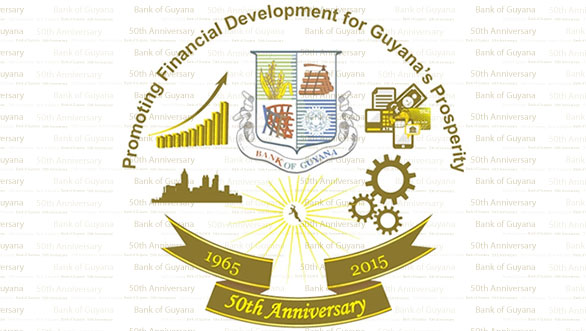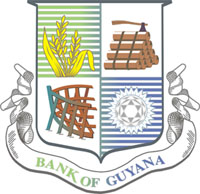The Bank of Guyana was established by virtue of the Bank of Guyana Ordinace No. 23 of 1965 and actual operations commenced on October 1965. The Bank of Guyana Act No. 19 of 1998 established the Central Bank as an autonomous institution governed by the Act.
A New Beginning

The Bank of Guyana was established by virtue of the Bank of Guyana Ordinance No. 23 of 1965. Its operations commenced on October 16. 1965 – seven months before the country gained political independence. The early establishment of the Bank was promoted by an agreement of the U.K. Government (acting for the still colonial members of the British Caribbean Currency Board (BCCB) and the Trinidad & Tobago Government), for the dissolution of the BCCB by mid-1967 and the cessation of issuance of currency after 1965.
The Bank of Guyana Ordinance established the Central Bank as an ‘autonomous institution’ with headquarters in the capital city of Georgetown with the following principal objectives:
Within the context of the economic policy of the Government, the Bank shall be guided in all its actions by the objectives of fostering monetary stability and promoting credit and exchange conditions conducive to the growth of the economy of Guyana.
Apart from specifying the administrative and management arrangements for the Bank, the Ordinance, inter alia, decreed the Bank to:
- have the sole right to issue and redeem notes and coins
- act as banker to the commercial banks
- act as fiscal agent and trustee of and banker to the Government
- administer payment agreements entered into by the Government
At its establishment, the Bank was housed in temporary premises in three locations. The Governor operated from an office assigned to him in the Parliament Building. Office space was rented from the Colonial Life Insurance Company, High Street, Georgetown, to house the Research Department while the BCCB’s office in the General Post Office Building, Georgetown, executed currency operations on behalf of the Bank.
The Bank commenced operations under the leadership of its first Governor, Dr. Horst Bockelman, who was seconded from the Bundesbank, Germany. A reputable banker with considerable experience, he had the advantage of participating in setting up the Central Bank in neighbouring Trinidad and Tobago.
The Governor was later supported by Mr. Kemal Sogancilar, who was appointed Banking Manager. He was seconded from the Central Bank of Cyprus but served earlier in the Turkish Central Bank.
All of the other positions were initially held by Guyanese. Two years later, Mr. William P. D’Andrade acceeded to the top position to become the first Guyanese Governor of the Bank. He was familiar to the workings of the Bank since he was an ex-officio member of the Board of Directors as a result of his substantive post of Secretary to the Treasury, Ministry of Finance and later served briefly as Deputy Governor.
The Bank begun issuing the new national currency notes on November 15, 1965, to replace the BCCB notes, the issuance of which was expected to cease by December 31, 1965. However, national coins were not issued until the mid 1967. Presently, the bank continues to have De La Rue and the Royal Mint as suppliers of the nation’s currency.
Furthermore, the Ordinance establishing the Bank was revised and became the Bank of Guyana Act. CAP:85:02. This Act was further revised in 1995, 1998 and latterly in 2004. The role and purpose of the Bank within the framework of Guyana’s economic and financial system were boosted with the later revisions. In addition, they imparted greater autonomy to the Bank in terms of its constitution, administration and operations.
The Logo – The Significance
 The Features of the Bank’s Logo are:
The Features of the Bank’s Logo are:
- The top left division depicts the Rice Industry.
- The top right division depicts the Timber Industry.
- The bottom left division depicts the Ship Building Industry.
- The bottom right division depicts the Minerals of Guyana.
Role of the BOG
The role of Bank of Guyana is to act as the Central Bank of Guyana. Its primary purpose is to formulate and implement monetary policy in order to achieve and maintain price stability.
The other major purpose is to foster a sound, progressive and an effective financial system. In the discharge of its functions, the Bank strives to:
- Promote a sustained and non-inflationary growth of the economy.
- Maintain the integrity and value of the Guyana dollar.
- Secure the credibility of the financial system, including payments arrangements, through supervision and oversight.
Functions of the BOG
The functions of the Bank of Guyana are as follows:
- To offer advice to the Government on economic management in order to achieve the desired course of economic events and minimise or avoid inconsistencies among various governmental policy measures.
- To offer advice on the efficacy of alternative policy instruments – exchange rates, interest rates and money supply.
- To monitor the functioning of the financial system and foster its development.
- To manage the foreign exchange reserves of the nation within the context of national policy.
- To operate such accounts of the Government as are assigned to the Bank.
- To manage the internal and the external public debt.
- To issue the country’s legal tender and to ensure the efficiency of the arrangements for payments and other forms of exchange.
- To co-operate with other Government agencies in facilitating international trade and payments
Services Offered
Retail Banking
- Encashment of Government Cheques
- Purchase of Specified Caricom Currency
- Domestic Cash Exchange
- Replacement of Mutilated Notes.
- Sales of Commemorative coins.
Banking Hours
Monday – Thursday
8:00 hrs to 12:00 hrs
Friday or the last day of the week
8:00 hrs to 14:00 hrs







